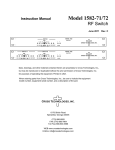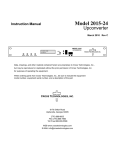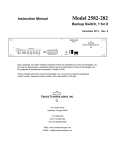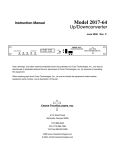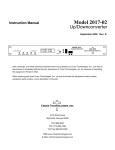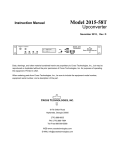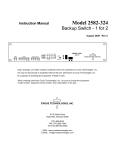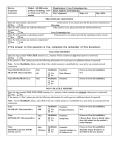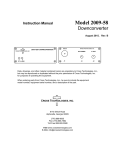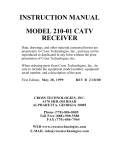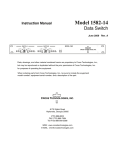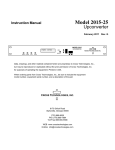Download Cross Technologies 1582-70L Instruction manual
Transcript
Model 1582-70L Instruction Manual Switch November 2009 Rev B SWITCH STATUS SERIES 1582 SWITCH 1 AUTO 2 1 CH 1 MANUAL ON-LINE SELECT CH 2 SWITCH ON-LINE RESET MANUAL REMOTE 2 ALARM 1 2 ALARM HISTORY 1 HISTORY RESET 2 CROSS T TECHNOLOGIES, INC. CROSS ECHNOLOGIES, INC. POWER Data, drawings, and other material contained herein are proprietary to Cross Technologies, Inc., but may be reproduced or duplicated without the prior permission of Cross Technologies, Inc. for purposes of operating the equipment. When ordering parts from Cross Technologies, Inc., be sure to include the equipment model number, equipment serial number, and a description of the part. CROSS TECHNOLOGIES, INC. 6170 Shiloh Road Alpharetta, Georgia 30005 (770) 886-8005 FAX (770) 886-7964 Toll Free 888-900-5588 WEB www.crosstechnologies.com E-MAIL [email protected] INSTRUCTION MANUAL MODEL 1582-70L Switch TABLE OF CONTENTS Warranty 1.0 General 1.1 Equipment Description 1.2 Technical Specifications 2.0 Installation 2.1 Input/Output Connectors 2.2 Controls and Indicators 2.3 Setup Instructions 2.4 Switch Mode Setup 3.0 Environmental Use Information 4.0 Theory of Operation PAGE 2 3 3 4 5 5 6 10 10 11 12 WARRANTY - The following warranty applies to all Cross Technologies, Inc. products. All Cross Technologies, Inc. products are warranted against defective materials and workmanship for a period of one year after shipment to customer. Cross Technologies, Inc.’s obligation under this warranty is limited to repairing or, at Cross Technologies, Inc.’s option, replacing parts, subassemblies, or entire assemblies. Cross Technologies, Inc. shall not be liable for any special, indirect, or consequential damages. This warranty does not cover parts or equipment which have been subject to misuse, negligence, or accident by the customer during use. All shipping costs for warranty repairs will be prepaid by the customer. There are not other warranties, express or implied, except as stated herein. CROSS TECHNOLOGIES, INC. 6170 Shiloh Road Alpharetta, Georgia 30005 (770) 886-8005 FAX (770) 886-7964 Toll Free 888-900-5588 WEB www.crosstechnologies.com E-MAIL [email protected] 1582-70L Manual, Rev. B Page 2 11/05/09 MODEL 21582-70L Switch 1.0 General 1.1 Equipment Description - The 1582-70L Switch provides AUTO or Manual latched relay switching between CH1 and CH2 RF signals.(DC - 1.5 GHz). Automatic control determines switch routing by monitoring alarm inputs on two channels (CH1, CH2) and selecting the initial source. Local and remote control of RF sources is also provided. Latching relays allow the switch to remain in its "current" state independent of power loss. The 1582-70L detects an external alarm condition on CH1 and CH2 by either a contact closure to ground or an open (selectable). Switching logic can be selected as follows: 1) CH1 Prime Mode - Switches from CH1 to CH2 only if CH1 alarms and CH2 is good Switches back to CH1 when it is no longer in alarm or when both CH1 and CH2 are in alarm 2) Latch to CH2 Mode - Switches to CH2 if CH1 alarms and CH2 is good. Latches to CH2. Push Manual Reset or ground Remote Reset pin to return to CH1 if it has no alarm or both CH1 and CH2 are in alarm. 3) Minimum AUTO switching, Initial Channel Select (ICS) Mode - Switch stays on channel last selected by Manual or Remote selection after return to AUTO. AUTO switching occurs only if current channel alarms and the other channel is clear. Switching is accomplished using latching relays so if power is removed from the 1582-70L, CH1 and CH2 RF will continue to go to the output selected prior to power loss and will remain there when power is applied assuming no change in alarm status from when power was lost. The channels can be manually switched by the front panel Manual Select switch. If operating in the ICS mode, the last channel manually selected (CH1 or CH2) will be the initial channel when returning the Manual Select switch to AUTO. External REMOTE contact closures can force selection of CH1 or CH2 when the Manual Select switch is in the AUTO position independent of the alarm conditions of CH1 or CH2. Front panel LEDs indicate alarms, alarm history (prior occurrence of alarms which have now cleared), switch conditions for CH1 and CH2, REMOTE or MANUAL operation and presence of power. RF connectors are BNC, female. Contact closure inputs are via barrier strip. Dual power supplies provide redundant power to the 1582-70L. The chassis is a 1 3/4” rack mount. SWITCH STATUS SERIES 1582 SWITCH 1 AUTO 2 1 CH 1 MANUAL ON-LINE SELECT CH 2 SWITCH ON-LINE RESET MANUAL REMOTE 2 ALARM 1 2 ALARM HISTORY 1 HISTORY RESET 2 CROSS T TECHNOLOGIES, INC. CROSS ECHNOLOGIES, INC. POWER FIGURE 1.0 1582-70L SWITCH 1582-70L Manual, Rev. B Page 3 11/05/09 1582-70L BLOCK DIA SWITCH X RF 1 SWITCH X RF 2 SWITCH X SWITCHED RF SWITCH Y RF 1 SWITCH Y SWITCHED RF SWITCH Y RF 2 CONTROL LOGIC 1 2 1 2 REMOTE 1 2 REMOTE ALARM SW. RST MON MR A E NM CH 1 AUT O CH 2 SWITCH RESET FIGURE 1.1 1582-70L BLOCK DIAGRAM 1.2 Technical Specifications 1582-70L Technical Specifications Switch Characteristics Impedance Type Isolation Switch time Insertion Loss Configuration Connectors, RF Conn, Alarm/Controls Controls MANUAL SELECT SWITCH RESET REMOTE HISTORY RESET Indicators, LEDs CH1 ON-LINE CH2 ON-LINE MANUAL ALARM CH1 ALARM CH2 ALARM HISTORY 1 ALARM HISTORY 2 POWER CH1 POWER CH2 REMOTE Other Mechanical Power 75 ohms Latching Relay >65 dB DC to 10MHz >50 dB to 1.0 MHz, >40 dB to 1.5 GHz 10 milliseconds 1 dB to 1.0 GHz 1.5 dB to 2.0 GHz DPDT 75 BNC, Female Barrier Strip Manually select CH1, CH2, or AUTO operation. If operating in the ICS mode, the last channel manually selected (CH1 or CH2) will be the initial channel. Resets switch to CH1 if it is good and switch is in the latch mode, Also Resets Resets alarm history (prior occurrence of alarms which have cleared) LEDs only Turns green when Channel 1 is selected Turns green when Channel 2 is selected Turns red when the Manual Select switch manually selects channel 1 or 2. Turns red when Channel 1 alarm input is a closure or open (selectable) Turns red when Channel 2 alarm input is a closure or open (selectable) Turns red on Channel 1 alarm and stays red until HISTORY RESET is pushed Turns red on Channel 2 alarm and stays red until HISTORY RESET is pushed Turns green when power is applied to AC1 input on the rear panel Turns green when power is applied to AC2 input on the rear panel Turns amber when REMOTE control is active 19 inch standard chassis 1.75” high X 12” deep Redundant power supplies; 100-240 ±10% VAC, 47 - 60Hz, 30 watts *Specifications subject to change without notice 1582-70L Manual, Rev. B Page 4 11/05/09 2.0 Installation 2.1 Input/Output Connectors - The following are the input and output connectors. AC1 AC2 B2 B B1 A2 J3 J4 J3 SW B RF 1 J4SW A RF 2 A A1 GND 1 AC1 POWER IN 1 1.5 A FUSE AC2 POWER IN 2 1.5 A FUSE J7 14 J7-MONITORS & CONTROLS J1 SW B RF 2 J1 J2 J2 - SW B SWITCHED RF J5 J6 J6J5- SW A SWITCHED SW A RF 1 RF FIGURE 2.0 1582-70L REAR PANEL TABLE 2.0 INPUT / OUTPUT CONNECTORS (FIGURE 2.0) J1, J2, J3, J4, J5, J6 - RF CONNECTORS (FIGURE 2.0) J7 - MONITORS AND CONTROLS CONNECTOR (FIGURE 2.0) Function ALARM 1 IN ALARM 2 IN REMOTE 1 IN REMOTE 2 IN REMOTE RESET IN MANUAL INDICATION SWITCH 1 MON SWITCH 2 MON SWITCH MON COMMON REMOTE MON GROUND NO CONNECTION Pin # 13 14 1 2 4 8 11 12 6 9 3,7,10 5 Description Ground or Open (selectable by JP2) is Ch 1 alarm. Ground or Open (selectable by JP2) is Ch 2 alarm. When in AUTO, momentary ground on this pin selects Ch 1. When in AUTO, momentary ground on this pin selects Ch 2. When in LATCH mode, ground resets switch to Ch 1. *Open collector output (< 5) to gnd when in Manual mode. **Relay closure to J7 pin 6 (<5) when selected RF is Ch 1 RF. **Relay closure to J7 pin 6 (<5) when selected RF is Ch 2 RF. Common pin for SWITCH 1, 2 MONITOR *Open collector (< 5) to gnd when in REMOTE mode Ground Not connected *Max voltage able to be connected to this is +20 VDC @ 30ma **Max voltage to be connected to this is +30 VDC@ 100 ma AC1, AC2 - POWER IN - Provides AC inputs for dual power supplies. *NOTE* When the 1582 RF Switch is installed into a system, J7 Pins 13 and 14 (Alarms In) and appropriate grounds must be interconnected between the primary(s), backup(s) and the 1582 RF Switch for proper switch function. 1582-70L Manual, Rev. B Page 5 11/05/09 2.2 Controls and Indicators -The following are the controls and indicators. SWITCH MODE STATUS SWITCH 1 AUTO 2 1 CH 1 ON- MANUAL SELECT CH 2 SWITCH MANUAL REMOTE ON-LINE RESET 2 ALARM 1 1 2 ALARM HISTOR HISTORY RESET 2 POWER FIGURE 2.2 1582-70L CONTROLS AND INDICATORS TABLE 2.1 FRONT PANEL CONTROLS AND INDICATORS Item Description CH1 ON-LINE LED Turns green when Channel 1 is selected CH2 ON-LINE LED Turns green when the Channel 2 is selected MANUAL LED Turns red when the Manual Select switch manually selects channel 1 or 2. ALARM CH1 LED Turns red when Channel 1 alarm input is a closure or open (selectable) ALARM CH2 LED Turns red when Channel 2 alarm input is a closure or open (selectable) ALARM HISTORY 1 Turns red on Channel 1 alarm and stays red until HISTORY RESET is pushed ALARM HISTORY 2 Turns red on Channel 2 alarm and stays red until HISTORY RESET is pushed POWER CH1 LED Turns green when power is applied to AC1 input on the rear panel POWER CH2 LED Turns green when power is applied to AC2 input on the rear panel REMOTE LED Turns amber when REMOTE control is active MANUAL SELECT 3-position switch as follows: 1 - manually select Channel 1 center - auto - switch position determined by alarm and Remote closures 2 - manually select Channel 2 If operating in the ICS mode, the last channel manually selected (CH1 or CH2) will be the initial channel. SWITCH RESET Resets switch to CH1 if it is good and switch is in the latch mode, Also Resets REMOTE selection to normal AUTO operation HISTORY RESET Resets history alarm LEDs only TABLE 2.2 PC BOARD SETTINGS NOTE: Dot position means jumper goes from pins 1-2; non-dot means jumper goes from pins 2-3 1582-70L Manual, Rev. B Page 6 11/05/09 JP1 - 3-pin jumper - 3-pin jumper that works with JP3 In the dotted position when channel 1 alarms the 1582-70 will switch to channel 2 until channel 2 alarms. At this point, if channel 1 is still in alarm, the switch will stay on channel 2. When the channel 1 alarm clears if channel 2 is still in alarm, the switch will switch to channel 1. JP1 normal position - non-dotted and operates in conjunction with JP3 as noted below. JP2 - Input alarm condition 3-pin jumper In the dotted position open is normal, ground is alarm In the non-dot position ground is normal, open is an alarm. JP2 normal position - dot JP3 - LATCH to CH2 mode on / off - 3-pin jumper effective when JP1 is in the non-dot position. With JP3 in the dot and JP1 in the non-dot, when channel 1 alarms, the 1582-70 switch switches to channel 2 and stays there until the reset button is pushed on the front panel or by an external closure to ground on the remote RESET pin on J7, and then it switches to channel 1. (If channel 1 alarms are cleared ). If in the ICS mode and originally set to CH2 the 1582-70 will not switch if CH2 alarms. Only the RESET functions (front panel pushbutton or J7 closure to ground) will return the switch to CH1. With JP3 in the non-dot and JP1 in the non-dot, when channel 1 alarms the 1582-70 switches to channel 2 until the alarm on channel 1 clears and then the 1582-70 switches back to channel 1 automatically. JP3 normally position - dot . JP4 - CH2 alarm enable / ignore - 3-pin jumper Dotted position - Failure in CH1 will cause the 1582-70 to switch to CH2 even if CH2 is in alarm. LEDs will correctly show CH2 alarm status Non-dotted position. Failure in CH1 will cause the 1582-72 to switch to CH2 only if CH2 is not in alarm. JP4 Normal position - non-dot SW4 - Initial Channel Select (ICS) Mode- 4-position DIP switch Selects the Initial Channel Select mode when JP1,2,3 in Dot and JP4 in Non-dot. S4 positions 1,2,3,4 to ON - ICS is enabled. In the ICS mode, the initial channel can be either CH1 or CH2 by switching the front panel Manual Select switch to either CH1 or CH2 and then back to the Auto position or by grounding either Remote 1 or Remote 2 pins on J8 and then grounding the Remote reset pin on J8 causing the 1582-70 to go back to Auto in the channel last selected remotely if both channel alarms are clear or both channels are in alarm. The initial channel can also be selected if both channel alarms are clear or both channels are in alarm. S4 positions 1,2,3,4 to OFF - ICS is disabled (Min. Auto switching, Return to Last State Mode) The 1582-70 goes to the last state (CH1 or CH2) it was in when in Auto after Manually or Remotely switching and returning to Auto. Auto switching occurs only if current channel alarms and the other channel is clear. S4 normal position - 1,2,3,4 to ON 1582-70L Manual, Rev. B Page 7 11/05/09 JP2 POWER SUPPLY 2 JP1 POWER SUPPLY 1 JP3 ROCKER DOWN O F F 1 2 3 4 JP4 1582-70L Manual, Rev. B S4 - ROCKER SWITCH DETAIL SHOWN WITH ALL SWITCH POSITIONS IN THE ON SIDE Page 8 JP1, JP2, JP3, JP4, AND S4 POSITIONS SHOWN ICS AND LATCHED MODE 11/05/09 1582-70L Manual, Rev. B Page 9 11/05/09 2.3 Setup Instructions a. b. c. d. Set the on board controls as desired (Tables 2.2, 2.3, Figure 2.3). Install the 1582-70 in the equipment rack. Connect RF to the BNC connectors (J1 - J3, J4 - J6)). Connect to signals on the MONITORS AND CONTROLS connector, J7, as desired (see Figure 2.0, Table 2.0) e. Connect power via two power cords f. Manually switch between channels 1 and 2 and be sure switching occurs g. Switch to AUTO. Alarm channel 1 and note that automatic switching occurs. Remove alarm to channel 1 and note that the output switches as desired. Push RESET if in LATCH mode. Repeat for Channel 2. h. Check that Ch 1 and Ch 2 are selected when in AUTO and momentary ground is applied to J7 pins (1) and (2) Momentarily ground remote Reset pin 4 on J7 if in LATCH mode to return to AUTO operation. 2.4 Switch Mode Setup - The following gives the switch mode settings of the on board controls that can be changed in the field with JP1, JP2, JP3, JP4; S4. ( Figure 2.3). All shown with external alarm = ground. 1) CH1 Prime Mode - Switches from CH1 to the CH2 only if CH1 alarms and CH2 is good. S witches back to CH1 when it is no longer in alarm or when both CH1 and CH2 are in alarm Non-dot JP1, JP3, JP4; Dot - JP2; S4 - ALL TO OFF. 2) Latch to CH2 Mode - Switches from CH1 to the CH2 if CH1 alarms and CH2 is good. Latches to CH2. Push Reset or ground Remote Reset pin to return to CH1 if it has no alarm or both CH1 and CH2 are in alarm. Non-dot - JP1, JP4; Dot - JP2, JP3; S4 - ALL TO OFF. 3) Minimum Auto switching, Initial Channel Select (ICS) Mode- Switch stays on channel last selected by Manual or Remote selection after return to Auto if both channel alarms are clear or both channels are in alarm. Auto switching occurs only if current channel alarms and the other channel is clear. Non-dot - JP4; Dot - JP1, JP2, JP3; S4 - ALL TO ON. Factory set mode is generally 1) CH1 Prime Mode. 1582-70L Manual, Rev. B Page 10 11/05/09 3.0 Environmental Use Information A. Rack-Mounting - To mount this equipment in a rack, please refer to the installation instructions located in the user manual furnished by the manufacturer of your equipment rack. B. Mechanical loading - Mounting of equipment in a rack should be such that a hazardous condition does not exist due to uneven weight distribution. C. Elevated operating ambient temperature - If installed in a closed or multi-unit rack assembly, the operating ambient temperature of the rack may be greater than room ambient temperature. Therefore, consideration should be given to Tmra. D. Reduced air flow - Installation of the equipment in a rack should be such that the amount of air flow required for safe operation of the equipment is not compromised. Additional space between unit may be required. E. Circuit Overloading - Consideration should be given to the connection of the equipment to the supply circuit and the effect that overloading of circuits could have on over current protection and supply wiring. Appropriate consideration of equipment name plate rating should be used, when addressing this concern. F. Reliable Earthing - Reliable earthing of rack-mounted equipment should be maintained. Particular attention should be given to supply connections other than direct connection to the Branch (use of power strips). G. Top Cover - There are no serviceable parts inside the product so, the Top Cover should not be removed. If the Top Cover is removed the ground strap and associated screw MUST BE REINSTALLED prior to Top Cover screw replacement. FAILURE TO DO this may cause INGRESS and/or EGRESS emission problems. 1582-70L Manual, Rev. B Page 11 11/05/09 4.0 Theory of Operation Cross Technologies 1582-70L Switch 4.1 Introduction - The 1582-70L Switch provides automatic and manual control of RF sources or loads depending on the user's application. Automatic control is facilitated by monitoring of alarm inputs and selecting the initial RF source. Local and remote control of RF sources is also provided. LED indicators are provided for Alarm and Alarm History ("CH1" and "CH2"), Power ("CH1" and "CH2"), Remote, Manual as well as "CH1" and "CH2" Select. Latching relays are an option that allows the switch to remain in its "current" state independent of power loss. 4.2 Circuit Description (Refer to Switch Matrix) 4.2.1 Auto Operation Assume that the jumper and switch settings are configured for "Normal Auto Switch Setting" as shown at the bottom of the matrix unless otherwise specified. Alarm inputs "1" and "2" are monitored by the "Auto Latch" (U4). This latch will only change states when the selected source is in an alarm state and the unselected source is in a not alarmed state. The alarm inputs first pass through U1A and U1B where they are either inverted (Low = Alarm - JP1 1-2) or not inverted (High = Alarm - JP1 2-3). The output of U1A (pin 3) is the Alarm 1 status where High = Alarm. The output of U1B (pin 6) is the Alarm 2 status where High = Alarm. These outputs then go to inputs on U6 and U4. A logic Low on the output of U4A (pin 3) = "1" is alarmed AND "2" is not alarmed. In this case the Auto Latch (U4) will be set to select "CH2". A logic Low on the output of U4B (pin 6) = "1" is not alarmed AND "2" is alarmed. In this case the Auto Latch (U4) will be set to select "A". If both alarm inputs are alarmed or both alarm inputs are not alarmed, the Auto Latch will not be affected. The output of the Auto Latch (U4 - pin 6) determines which RF source will be selected (in auto mode only) where a logic High = Select "CH2". The Auto Latch logic then passes through the remote control circuitry, which without remote control asserted, will not affect the logic levels. After the remote circuitry the logic signal passes through the manual control circuitry, which without manual control asserted, will not affect the logic levels. After the manual control circuitry, the logic is either applied directly to the relay drivers (High = Select "CH2") for non-latching relays or is routed through U9A and U10 for latching relay versions. For models with latching relays the logic signal first passes through U9A that provides a relay pulse to ensure that the relays will all be set to the same state on power-up. R28 and C7 provide a pulse to the dual "one-shot" (U10) The outputs of U10 provide the relay set (U10 pin 6) and reset (U10 pin 10) pulses for the latching relays. A "Set" pulse selects "CH1" and a reset pulse selects "CH2". U12A and U12B provide a "lock out" that eliminates the possibility of a set and reset pulse occurring simultaneously by "resetting" each other's "oneshot" during a set or reset pulse. 1582-70L Manual, Rev. B Page 12 11/05/09 4.2.2 "CH1" As Primary Source Operation (JP1 2-3 and JP3 2-3) With the jumpers in this configuration the Auto Latch will always select "CH1" unless "CH1" is alarmed and "CH2" is not alarmed. This is accomplished by grounding the reset on the Auto Latch via JP1 and JP3. 4.2.3 Restore "CH1" On Reset (JP1 2-3 and JP3 1-2) This configuration will cause the switch to remain in the "Select CH2" state, after an "CH1" is alarmed and "CH2" is not alarmed condition occurs, until a remote or manual reset is actuated. This is accomplished by tying the Auto Latch reset to the internal reset logic of the switch via JP1 and JP3. 4.2.4 Remote Operation Remote "CH1" and Remote "CH2" inputs are used for control of the switch from a remote location. These inputs will override the Auto Latch and therefore any switching that is a result of alarm conditions. The remote inputs will not override Manual operation. The remote inputs are latched by U4C and U5A (Remote "A") and U4D and U5B (Remote "CH2"). These latches allow the remote operation of the switch using a momentary contact closure to ground. A momentary closure on the Remote "CH1" input will set the latch causing a logic Low to be present on U5 pin 12. This low is applied to pin 2 on U7 forcing its output high (U7 pin 12). U1 pin 10 is high, inverting the output on U7 pin 12 causing a logic low to appear on U1 pin 8. A logic low at this point equal "Select CH1". A momentary closure on the Remote "CH2" input will set the latch causing a logic Low to be present on U5 pin 6. This low is applied to pin 13 on U7 forcing its output high (U7 pin 12). The logic Low from U5 pin 6 is also applied to U1 pin 10 pin which cause the XOR gate to not invert the output on U7 pin 12 causing a logic high to appear on U1 pin 8. A logic high at this point equal "Select CH2". A momentary contact closure to the remote reset or a manual reset will reset both latches restoring the RF switch to Auto operation. If either remote latch is set U8 pin 6 will be high. If the Manual switch is in the Auto position, U8 pin 8 will also be at a logic high. In this condition U8 pin 8 will be low causing a remote LED indication as well as providing a remote open collector output on Q2. 4.2.5 Manual Operation The Manual switch on the front of the RF switch provides local control of the RF switch. The Manual operation overrides Auto and Remote operation of the switch. When the Manual switch is in the Auto position, U1C and U7B have no affect on the logic level from the auto and remote circuitry. When the Auto switch is in the "Select CH1" position, U7 pin 4 is forced low causing U7 pin 6 to a logic high. Because U1 pin 13 is high, U1D inverts the logic high on U7 pin 6 cause a logic low to appear at U1 pin 11. A logic low at this point equals "Select CH1". When the Auto switch is in the "Select CH2" position, U7 pin 5 is forced low causing U7 pin 6 to a logic high. Because U1 pin 13 is also forced low, U1D does not invert the logic high on U7 pin 6 causing a logic high to appear at U1 pin 11. A logic high at this point equals "Select CH2". If either Manual position is selected, either pin 1 or pin 2 on U8 is forced low causing U8 pin 3 to be forced high. The logic high on U8 pin 3 will provide a Manual LED indication as well as a Manual open collector output on Q1. 1582-70L Manual, Rev. B Page 13 11/05/09 4.2.5 Initial Channel Select (ICS) or Auto Latch Tracking S4 provides the user with a method to force the Auto Latch to follow the remote or manual inputs. This feature eliminates unnecessary switching when moving between either Manual or Remote operation back to Auto operation. The Remote and Manual logic signal are routed to inputs on the Auto Latch that cause it to "track" the RF switch state. This feature can be enabled or disabled by opening or closing the switches on S4. Normally S4-1 and S4-2 would be both open (disabled) or both closed (enabled) to cause the Auto Latch to track the Manual switch control. Additionally, S4-3 and S4-4 would both be open (disabled) or both be closed (enabled) to cause the Auto Latch to track the Remote control operation. 4.2.6 Reset Operation Remote Reset and Manual Reset are combined by U7C and then inverted by U8C. This reset signal is used to reset the Auto Latch (See Restore "CH1" on Reset) and to reset the remote control latches (See Remote Operation). 4.2.7 Alarm History Reset The Alarm history is maintained by U2A (Alarm "1") and U2B (Alarm "2"). Any momentary alarm condition will be latched by this circuitry providing an alarm history indication. These alarm history indicators will remain illuminated, once latched, until the alarm history reset is actuated. It should be noted that the "Ignore B Alarm" configuration has no affect on the "CH2" alarm history indicator. 4.2.8 Power Indicators Power indicators DS9 and DS10 are provided to show the presence of DC power. 1582-70L Manual, Rev. B Page 14 11/05/09 CROSS TECHNOLOGIES, INC. 6170 Shiloh Road Alpharetta, Georgia 30005 (770) 886-8005 FAX (770) 886-7964 Toll Free 888-900-5588 WEB www.crosstechnologies.com E-MAIL [email protected] Printed in USA 1582-70L Manual, Rev. B Page 15 11/05/09















